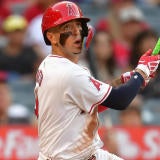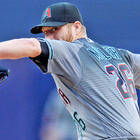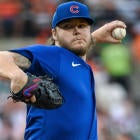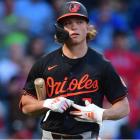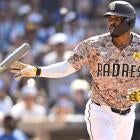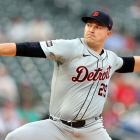We look ed Monday at some starting pitchers you might have invested an early pick in who have gotten off to disappointing starts. That exercise mostly aimed to calm the nerves of potentially panicky Fantasy owners, mostly because these were elite pitchers with strong track records.
Not every slow start is something you can just brush off. While it is obviously worth waiting on Corey Kluber to figure it out, it's a bit less obvious with more marginal starting options. You might think it is worth waiting on your mid-rotation starters to figure it out, but there's a chance they never recover from their slow starts, or just can't do enough to make up for the damage they might be causing.
Fantasy owners might be starting to look to cut bait as we get to the one-tenth mark of the season, so it makes sense to look at some struggling starters in that middle rang eof the starting pitching landscape, to see how strongly you should be holding on to these players. In this instance, the "Panic-O-Meter" has been replaced by the "Drop-O-Meter." In this system, a "0" means there's no way you should consider dropping the player, a "5" means you have to start thinking about it, and a "10" means you should have dropped him last week.
We've gotten the good, the bad and the ugly from Carlos Rodon through his first three starts. The good was his seven strong innings against the Athletics in his opener, when he struck out six and allowed just one walk in a tough-luck loss. The bad was actually still pretty good, as Rodon tossed six shutout innings against the Twins on the 13th, despite five walks in the outing. The ugly was Monday evening, when he was tagged for five runs and recorded just one out on 41 pitches. Rodon walked two, allowing six hits and was charged with five runs in the loss, which raised his ERA to 4.73 on the season. There have been some positive signs and just about as many negative signs, which is a bit disappointing since it seemed like he was starting to put things together at the end of last season; Rodon had a 2.28 ERA in August and September, with 52 strikeouts to just 23 walks, a major improvement in the latter regard. When Rodon is on, his slider is one of the toughest pitches in baseball, but consistency is clearly still an issue. You had to have considered that a possibility coming into the season, so it doesn't make much sense to overreact here. Ride it out. Drop-O-Meter: 2
Last season was a mirage for Shelby Miller in a lot of ways. He probably was never going to be good enough to post a 3.02 ERA again, but he was also not going to lose 17 games again, especially not with a move to a Diamondbacks team that looked like a potential contender. Miller's 3.45 FIP and 4.07 xFIP suggested regression was on the way, though nobody saw this coming; Miller has been tagged for 12 runs in 12 2/3 innings of work in his first three starts. Miller is giving up more flyballs than he did a year ago, and that has led to five homers and counting. Miller is throwing fewer two-seam fastballs, according to BrooksBaseball.com, but that hardly seems to account for the difference in performance, because the two-seamer has never been a particularly strong pitch for him. Miller's velocity is down from last April, when averaged 94.9 MPH on his fastball, but a 1 MPH drop is hardly worthy of alarm. For whatever reason, Miller is just getting crushed right now, and it's hard to come up with a really good explanation beyond simple execution. Miller probably isn't ever going to be an ace, but he's better than this, and is worth hanging on to. Drop-O-Meter: 5
As with Rodon, we've seen one great start from Collin McHugh, one absolute disaster, and one somewhere on the spectrum between. Like Rodon, McHugh has also mostly pitched to what our reasonable expectations should have been, 6.39 ERA notwithstanding; his 3.12 FIP is right in line with overall expectations, a bit lower than last year perhaps, but not so much so that it is evidence of a breakout. His strikeout rate (17.5 percent) and walk rate (4.8 percent) are both in line with what we've come to know of McHugh, if just a bit lower in both respects. McHugh's pitch selection is nearly identical to last season too, as he throws his cutter about 40 percent of the time, so it makes sense that the peripherals are largely similar. The good news is they should eventually lead to the pitcher we were expecting; the bad news is, that probably won't be the guy who looked like he might be breaking out as a potential ace in 2014. Drop-O-Meter: 3
Michael Pineda is one pitcher I've liked a lot since the start of last season. He started fixing some of the issues that limited his potential early in his career, developing a changeup and upping his groundball rate to the point where homers might conceivably not be a problem. Of course, they still were a problem. He allowed 1.2 HR/9 last season, and has been tagged for three in two starts to open the season, which is not a great sign. That just might be an issue for Pineda moving forward, especially when he plays in the AL East, with half of his games coming in Yankee Stadium. Still, even if he is fated to be homer prone forever, Pineda should still be better than his 4.37 ERA from last season, as his 3.34 FIP and 2.95 xFIP show. With a strikeout per inning and solid control, that is a starting Fantasy pitcher. Drop-O-Meter: 3
When you drafted Scott Kazmir, you probably did so with the expectation that he wasn't going to pitch consistently deep into games for you, so his 14 innings in three starts isn't too much of a concern. He has averaged fewer than six innings per start in each of his last three seasons after all. However, you certainly expected better than this. Kazmir has tossed just four innings in each of his last two, while allowing 10 runs in his first 14 innings of work. The strikeout rate has been fine, and the walk rate isn't outlandish, but Kazmir has been tagged for three homers and has already uncorked two wild pitches, so it's hard to say he's been anything close to good. Kazmir's velocity and pitch selection are right in line with recent seasons, however, so there aren't exactly a ton of warning signs. Kazmir has these kinds of runs from time to time, as when he pitched just 17 2/3 innings in a span of four starts last May and June, but he ripped off a run with a 1.35 ERA in his next seven starts. Kazmir's upside is high enough to wait on, even if he isn't quite a sure thing at 32. Drop-O-Meter: 4
Luis Severino flashed ace potential last season, posting a 2.89 ERA and 8.09 K/9 in his first 11 starts, but there was some reason to believe the talented then-21-year-old was pitching over his head. His FIP for the season was 4.37 thanks to a sky-high HR/FB rate, though even his xFIP of 3.72 doesn't look quite so pretty. Severino did a solid job of racking up groundballs, so homers really shouldn't be that big of an issue for him, but he didn't have quite as good control as expected. Given his success avoiding free passes in the minors, that shouldn't be much of a concern, and it hasn't been in two starts so far. With three solid pitches and a fastball he can routinely dial up to the mid-to-high-90's, Severino remains someone worth betting on, and might be the last one I would drop on this list. Drop-O-Meter: 0
Mike Fiers inspires a level of confidence that probably isn't befitting of his skill set. He's had some tremendous stretches, most notably whe he posted a 2.13 ERA in 71 2/3 innings in 2014, but his overall track record is pretty pedestrian. He posts strong strikeout numbers overall, sitting just below one K per innings for his career, and has solid control, walking 7.2 percent of batters he has faced for his career.However, Sunday's start against the Tigers was a perfect illustration of why I've had so much trouble buying into Fiers; He cruised through the first four innings and the Astros staked him to a 5-0 lead, which he nearly managed to give back, as he surrendered three homers in the next inning and two-thirds, giving him six homers allowed in 16 2/3 innings. Fiers doesn't have great stuff, with a fastball that sits in the high-80's and a changeup that doesn't typically gain much velocity separation, so command is a key for him. He's a great example of the difference between command and control, actually; Fiers rarely has issues finding the strike zone, but he runs into trouble when he spots his pitches in the wrong place. Some pitchers can get away with missing by a few inches because of their pure stuff, but Fiers tends to get hit hard when he isn't perfect. The margin for error is so small, it often feels like you're chasing uncatchable odds with Fiers. Every once in a while he'll catch fire and make it look stupid, but I don't think you'd miss Fiers if you dropped him to speculate on someone like Adam Conley. Drop-O-Meter: 7















